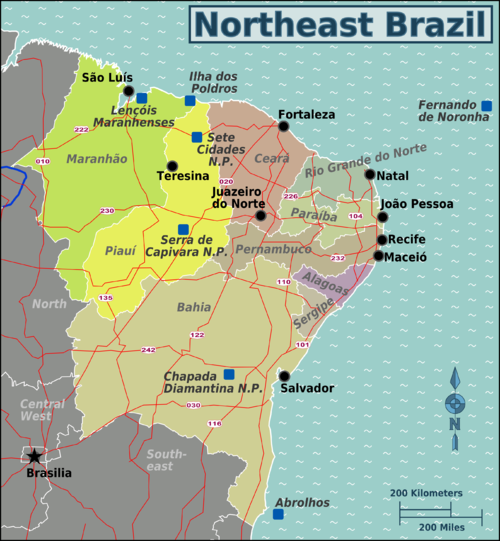RIO DE JANEIRO, BRAZIL – Northeastern state governments have begun to devise strategies faced with the prospect of a rapid surge in covid-19 in the coming weeks. The concern is also growing as new strains are detected.
Many locations have begun to report an upward trend in cases and hospitalizations, which has triggered alarms, prompting measures such as curfews and a tender for a new hospital.
No state in the Northeast has experienced death rates similar to the first wave since November.
This milder scenario led the region to achieve Brazil’s lowest mortality rate in late January. The South, which formerly held this position, now registers 98 deaths per 100,000 inhabitants, while the Northeast reaches 95 deaths per 100,000 inhabitants. The North is leading with 138 deaths per 100,000 people. The national average stands at 116 per 100,000 inhabitants.
However, some Brazilian states are experiencing a new explosion of cases, with a faster growth than in the first wave, resulting from the new strains.
On Wednesday, Bahia confirmed community transmission of the UK variant. The state is reporting a significant increase in the daily number of deaths. On January 30th, the 14-day rolling average stood at 32.3. It now stands at 52.8. There were 67 deaths recorded yesterday – the highest figure this year. A curfew is in effect from 10 PM to 5 AM.
“We have our own infection dynamic: it starts in one location and then spreads. There is a wave spreading across the country, just not at the same time. We have different sized peaks,” said Fernanda Grassi, researcher at Fiocruz (Oswaldo Cruz Foundation) and professor at Bahia School of Medicine and Public Health.
Grassi says that the upward trend in Bahia can be repeated in other states in the region. “We saw what happened in Manaus, with the emergence of strains. It is a very serious situation, they have a higher transmission capacity and we need to redouble care, such as mask wearing and distancing, perform massive testing and, most of all, vaccination. As soon as possible,” she explains.
More states find new strains
Alagoas also announced yesterday its first two cases of the P.1 variant. One of them has no history of travel or contact with people who passed through Amazonas. “This suggests that this coronavirus strain is now circulating here,” says state Health Secretary Alexandre Ayres.
Stricter measures have not yet been implemented because ICU bed occupancy stands at 62% of the total.
On February 10th, Paraíba state also confirmed the circulation of the new strain after testing samples from three patients.
In Maranhão state, where the Brazilian P.1 variant is probably in circulation, an upward trend in deaths has also been observed in recent days, with the average almost doubling in a week. ICU bed occupancy has reached 82% in São Luís and 87% in Imperatriz.
In Pernambuco state, there are two confirmed cases of the new P.1 variant from patients coming from Manaus. The increase in cases and deaths is still slow, but ICU bed occupancy yesterday reached 85% of the total 995 available.
“We can’t underestimate this number of cases and the potential congestion of healthcare networks. The next few days will be decisive for the pandemic. People’s behavior will determine the course of the disease,” says the Pernambuco Health Secretary André Longo.
The government has extended for another 30 days the ban on concerts and parties, in addition to the adoption of social distancing measures in bars and restaurants.
The secretary’s forecast is that the numbers will grow and reach a new peak within a few weeks and furnishes the basis for putting out a tender for a new field hospital to handle the increased cases.
“We have already published calls for tenders for our field hospital. We expect it to be ready by the end of March or early April, the period when the pandemic is expected to progress further and when there is a higher outbreak of respiratory diseases in the state,” he says. The facility will have 432 beds (132 intensive care beds).
Restraint in Ceará state
The first state to experience a peak of covid-19 in the first wave in the region, Ceará state also toughened measures this week and decreed a curfew from 10 PM to 5 AM, effective February 19th. Schools and universities have also suspended classes.
The alarm triggered by the circulation of new strains – and an increase in virus transmission – is the demand for healthcare services. The average rate of ICU bed occupancy for adults has reached 90%, the highest since the peak.
In Fortaleza, the search for UPAs (Emergency Care Units) reached unprecedented levels. The record of 12,265 patients in one month had occurred in April 2020 – equivalent to 408 per day. By February 15th, there were 10,909 suspected cases – equivalent to 727 per day.
“Some researchers call this a ‘surge in hospitalizations.’ Combined with the shift in hospitalizations to younger age groups, the increase in the number of reinfections and the severity of cases are an alert for the potential circulation of new strains,” says epidemiologist Antônio Lima Neto, who works at the Health Secretariat and a professor at Unifor (University of Fortaleza).
“I don’t believe in the impact of vaccination on hospitalizations and mortality before mid-April. There was no uniformity in the criteria. With rare exceptions, they vaccinated many ‘healthcare professionals’ not on the front-line, to the detriment of seniors who needed it urgently.”


